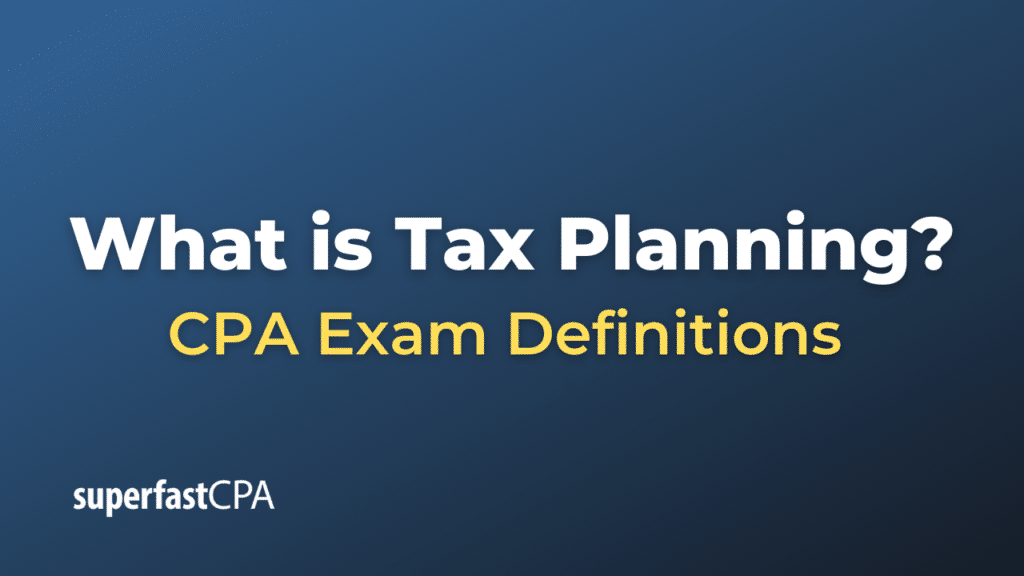Tax Planning
Tax planning refers to the practice of organizing one’s financial affairs in a way that minimizes the tax liability within the legal framework. It involves understanding various tax provisions available to taxpayers, both individuals and businesses, and making informed decisions to take advantage of those provisions. Effective tax planning ensures that an individual or business pays the least amount of tax required by law.
Key principles and objectives of tax planning include:
- Reduction of Tax Liability: The primary objective is to reduce the amount of taxable income, thereby reducing the tax payable.
- Minimization of Litigation: Organizing financial affairs in a way that avoids ambiguities and discrepancies, which can lead to disputes and litigation with tax authorities.
- Productive Investment: Channeling investments in avenues that offer tax incentives without compromising on the return on investment.
- Maximizing Benefits: Taking full advantage of all permissible deductions, exemptions, rebates, reliefs, and credits available under the tax laws.
- Ensuring Compliance: Ensuring that all tax planning strategies are in compliance with the law to avoid penalties and legal consequences.
- Forecasting Tax Liability: Estimating future tax obligations to aid in better financial planning and budgeting.
Common tax planning strategies include:
- Timing of Income: Depending on the tax bracket one is in, it might be beneficial to defer or accelerate income.
- Deductible Expenses: Claiming all eligible tax deductions, like those for mortgage interest, medical expenses, or business-related expenses.
- Tax-Advantaged Investments: Investing in tax-advantaged or tax-deferred accounts like IRAs, 401(k)s, or certain education savings accounts.
- Income Splitting: Distributing income among several family members or legal entities to keep it in a lower tax bracket.
- Choosing the Right Business Entity: For entrepreneurs and business owners, selecting the most tax-efficient business structure (sole proprietorship, partnership, corporation, etc.) can make a significant difference in tax liability.
- Tax Credits: Taking advantage of available tax credits, which reduce tax liability directly.
- Tax Loss Harvesting: Selling securities at a loss to offset a capital gains tax liability.
- Gifting: Transferring assets to beneficiaries to reduce estate taxes or to shift income to someone in a lower tax bracket.
- leveraging Tax Treaties: For those dealing internationally, understanding and leveraging tax treaties between countries can help avoid double taxation.
- Estate Planning: Planning for the transfer of assets to beneficiaries in ways that minimize the tax liability.
It’s important to differentiate tax planning from tax evasion. While tax planning uses legitimate means and stays within the bounds of tax laws to reduce tax liability, tax evasion involves illegal practices to avoid paying taxes and is punishable by law.
Given the complexity of tax laws and the importance of making the right decisions, many individuals and businesses seek the advice of tax professionals or financial advisors to help with their tax planning.
Example of Tax Planning
Let’s explore tax planning through a hypothetical scenario involving an individual named Tom.
Background: Tom is a software engineer living in the U.S. He earns an annual salary of $100,000 and has additional income from some freelance projects amounting to $20,000. He also has some investments in stocks and a rental property.
Tax Planning Actions:
- 401(k) Contributions:
- Tom’s employer offers a 401(k) plan with a matching contribution up to 5% of his salary.
- Tom decides to contribute the full 5% ($5,000) to his 401(k), and with his employer’s match, a total of $10,000 gets added to the account.
- This reduces his taxable income to $90,000 because 401(k) contributions are tax-deferred.
- IRA Investment:
- Tom also contributes $6,000 to a Traditional IRA, which is tax-deductible, reducing his taxable income further to $84,000.
- Rental Property Deductions:
- From his rental property, Tom earns $12,000 in annual rent.
- However, he incurs expenses, including mortgage interest, property taxes, maintenance, and depreciation, totaling $8,000.
- This means his taxable income from the rental property is only $4,000.
- Tax Loss Harvesting:
- Freelance Business Expenses:
Summary:
- Original Income: $100,000 (salary) + $20,000 (freelance) + $12,000 (rental) + $3,000 (stock gains) = $135,000
- Deductions and Adjustments: -$10,000 (401(k) including employer match) – $6,000 (IRA) – $8,000 (rental expenses) – $2,000 (stock loss) – $5,000 (freelance expenses) = -$31,000
- Final Taxable Income: $135,000 – $31,000 = $104,000
Through strategic tax planning, Tom effectively reduced his taxable income from $135,000 to $104,000, potentially saving him a significant amount in taxes.
It’s worth noting that the above example is a simplified illustration and might not capture all the nuances of the U.S. tax code. Always consult with a tax professional for personalized advice.













